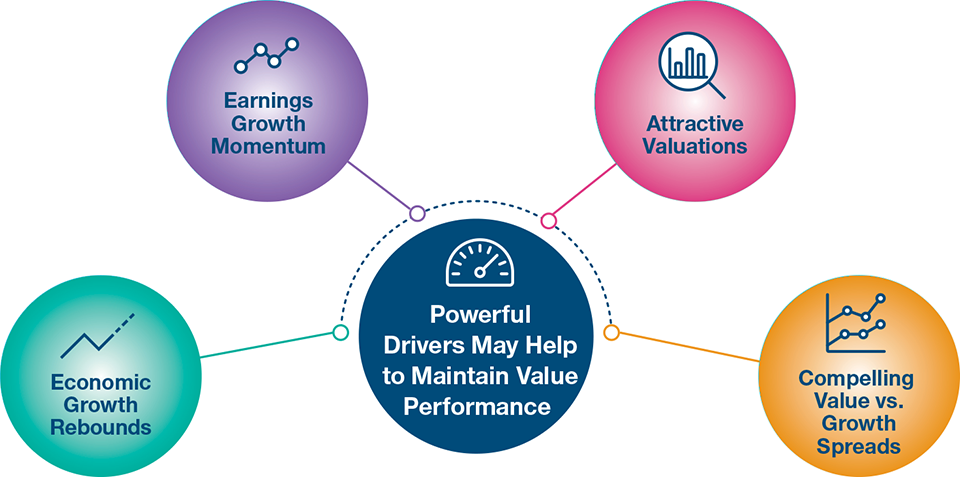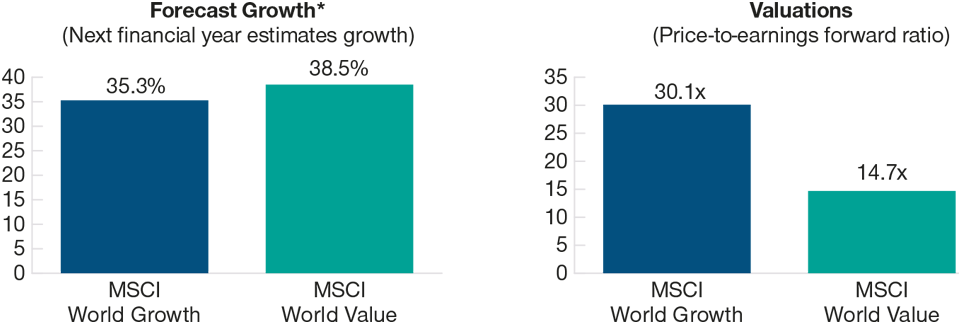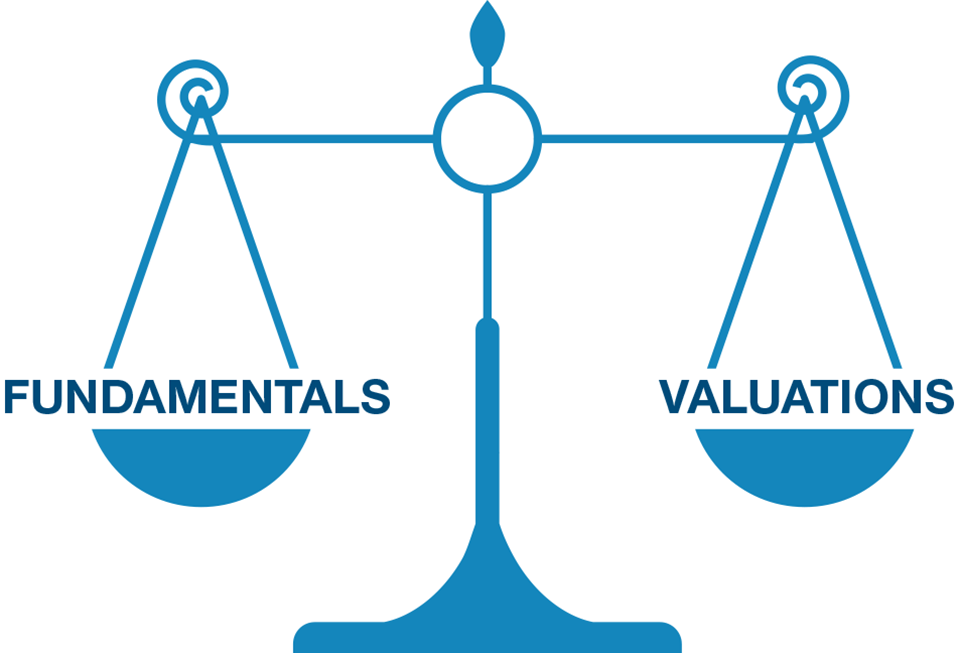July 2021 / INVESTMENT INSIGHTS
Why This “Value” Recovery May Have Only Just Begun
Economic recovery and earnings momentum set to sustain the rotation back to value
Key Insights
- Economic recovery, earnings momentum, and attractive valuations can keep the “value” recovery going.
- The valuation spread between value and growth stocks has only just moved from extremes.
- For investors seeking a balanced portfolio, we believe value is an essential component of an investment strategy.
Value as an investment style is enjoying a revival. After being described as moribund by some, we started to see a rotation from “growth” to “value” in late summer 2020, accelerating in November on the news of Pfizer’s COVID‑19 vaccine. The outperformance of value has continued year‑to‑date (Figure 1), as economies have opened up and economic and earnings growth have bounced. However, some are questioning the durability of this rally, while others are asking whether they have missed the opportunity to participate in the recovery.
“Value” Has Outperformed as Economic Growth and Cyclical Companies Earnings Have Rebounded
(Fig. 1) Value has outperformed growth by 7.8% since September 1, 2020

Past performance is not a reliable indicator of future performance.
September 1, 2020, to June 30, 2021.
Sources: MSCI and FactSet. Financial data and analytics provider FactSet. Copyright 2021 FactSet. All Rights Reserved (see Additional Disclosures).
Encouragingly, we believe there are several factors that can help sustain the rotation back to an investment style that has underperformed for so long.
Four Reasons Why This Value Recovery May Have Only Just Begun
Powerful drivers look set to support rotation back to value

For illustrative purposes only.Source: T. Rowe Price.
Economic Recovery, Earnings Improvement, Attractive Valuations, and Valuation Spreads vs. Growth Stocks Provide Positive Backdrop
In our last T. Rowe Price Insights (Why the Future Now Looks Brighter for Value Investing) in November 2020, we spoke of the possibility that “the world could be set for a cyclical bounce in 2021.” This proved accurate, but even we have been surprised by how much economies have rebounded. Economic recoveries historically have favored value areas, and this one has been no different with traditional value sectors leading the way (Figure 2). Much of this has been due to a meaningful improvement in earnings estimates, especially for sectors like energy, financials, and materials. Growth‑oriented areas have also seen a rise in earnings expectations, but nothing like for value areas of the market. This has not been only limited to U.S. equity markets; value has outperformed across most equity markets.
We expect this momentum to be maintained as a combination of lower valuations and better earnings estimates are set to support the rally (Figure 3). This positive backdrop is further enhanced by ongoing fiscal stimulus, massive pent‑up demand, and the prospects of fully reopened economies, which should all help maintain earnings growth over the short to medium term.
Leadership From Traditional Value Sectors
(Fig. 2) Energy, financials, and materials have seen the biggest increase in earning expectations

Past performance is not a reliable indicator of future performance.
December 31, 2020, to June 30, 2021.
Sector performance returns are for the MSCI World Index. Earnings Change are provided by FactSet.
Sources: MSCI and FactSet. Financial data and analytics provider, FactSet. Copyright 2021 FactSet. All rights reserved (see Additional Disclosures).
Value Offers Both Higher Potential Earnings Growth and Lower Valuations
As of June 30, 2021.
*There is no guarantee that any forecasts made will come to pass.
Sources: MSCI and FactSet. Financial data and analytics provider, FactSet. Copyright 2021 FactSet. All rights reserved (see Additional Disclosures).

Even though value has outperformed growth over the last six months, we believe this has just started to shift the needle in terms of long‑term performance. This only represents the early recovery from the extreme valuation spreads seen when the crisis hit. Valuation spreads between growth and value reached unprecedented levels then, in the order of around 4 standard deviations, higher than both the global financial crisis (GFC) and the technology, media and telecoms (TMT) bubble in 1999–2000. Valuation spreads have now moved from these extremes but remain very attractive compared with their normal pattern, at around 1 standard deviation.
Value’s Recent Outperformance is Modest in the Longer Term Context
(Fig. 4) After a decade of “growth” dominance, we may be starting to see a reversal

Past performance is not a reliable indicator of future performance.
As of June 30, 2021.
Blue shaded areas represent “growth stocks” outperformance period. Grey shaded areas represent “value stocks” outperformance period.
Sources: MSCI and FactSet. Financial data and analytics provider, FactSet. Copyright 2021 FactSet. All rights reserved (see Additional Disclosures).
The performance of value and growth indices shows a similar pattern of recent recovery, but we are still in a position where the attractiveness of value remains. Figure 4 shows the performance differential between the MSCI World Value Index and the MSCI World Growth Index. So far, we have only seen a partial recovery from the deepest and most prolonged period of value underperformance for at least 50 years.
Yield Curve Steepening and Building Inflationary Pressures Favor Value‑Oriented Areas of Market
More fundamentally, we have talked in the past about how inflation is needed to deliver a more sustained rotation to value. Here, we see fiscal deficits as a likely source of upward pressure on interest rates and inflation. U.S. consumer prices accelerated by the most in nearly 13 years in May (+5.0% year over year) as pent‑up demand combined with higher prices for goods stoked inflationary pressures. While the recent surge in prices can partly be attributed to the low levels of inflation at the start of the coronavirus pandemic, we have also seen a sharp increase in demand for items such as automobiles, hotels, and flights as economies have reopened.
Meanwhile, the already sizable fiscal stimulus that the government has injected into the U.S. economy is being supercharged by President Joe Biden’s spending plans. The combination of the American Jobs Plan and the recently announced American Families Plan, the second phase of the “Build Back Better” platform, provides the potential for additional spending on infrastructure and could create the potential for stronger economic growth for a number of years ahead.
The broader investment perspective is whether these plans are a precursor to a permanent shift higher in fiscal spending, and whether they can be financed in a fiscally neutral way or if it will result in a marked increase in budget deficits over the longer term. If this were to be the case, then the market potentially may focus on the longer‑term implications for both interest rates and inflation. Also, if markets were to begin to expect that systematically higher rates of inflation were likely, this could well reverse many of the pronounced market trends that we have seen over the last decade and possibly herald a more prolonged value regime.
Opportunity Still Exists, With International Markets a Key Focus
Despite the recent change in fortunes, there are still many areas that offer opportunities. With valuations in the U.S. looking a little more expensive, we have been looking to international markets. Markets have often tracked vaccination trends, so weaker vaccination rates have meant that Europe, Japan, and parts of emerging markets have underperformed this year. India is a good example. We expect India to recover in the second half of 2021 as it should emerge from an extremely difficult period of infections. China, meanwhile, also offers the combination of a strong currency, cheap valuations, robust growth, and an increasing market sophistication. Our well‑resourced research team, including investment professionals in our new Shanghai office, are helping us to uncover exciting opportunities, particularly in the mid‑cap space.
On a sector basis, the reopening of economies is a key focus. Transportation is a good example, with European auto stocks looking attractive, while we also see good value in some airline and aerospace stocks. We also have exposure to the pharmaceutical industry. The industry has been out of favor due to uncertainties around health care reforms in the U.S. Stocks in this space have tended to be defensive and grow more slowly, but valuations are now back at 2011–2012 levels.
Balancing Both Fundamentals and Valuation Appeal Is Critical to Investment Success, Regardless of Investment Style
For investors seeking a balanced portfolio, we believe value is anessential component

A New Decade—Balancing Both Fundamentals and Valuation Appeal Is Crucial to Investment Success
As we look forward, we believe the coming decade will look very different from the last. Markets tend to change significantly every 10 to 15 years. Since the GFC, a prolonged period of secular stagnation has been accompanied by low rates and subdued economic growth. Globally, an increasing move toward populism against a backdrop of rising inequality is widely seen as unsustainable. The pandemic has prompted more aggressive, expansionary fiscal and monetary policies, approaching modern monetary theory. Actions to address inequality and the “green agenda” could also provide impetus for even higher fiscal spending. These changes could help to improve economic growth, which in turn could put upward pressure on both interest rates and inflation. This environment would be favorable for cyclicals, financials, and consumption stocks, to the likely benefit of a value investing approach.
Value investors should, however, not forget the lessons that disruption and technological innovation have had on many traditional industries—a trend that the coronavirus pandemic appears to have accelerated. Innovation has been widespread, disrupting sectors that have been overly represented in value. The sharp recovery rally in value stocks lifted all boats during this early phase, but going forward it will likely be more nuanced.
More fundamentally, we believe it will be crucial to focus on the best companies at the right time in their cycle. The price you pay for each currency of earnings will always matter. Properly balancing fundamentals and valuations remains key. Importantly, with current valuations remaining attractive, an economic recovery in full flow, and earnings delivering above expectations, we believe this rally may only just be beginning and could potentially herald a more sustained shift back toward value as an investment style. For investors seeking a balanced portfolio, we believe value is an essential component of an investment strategy.
IMPORTANT INFORMATION
This material is being furnished for general informational and/or marketing purposes only. The material does not constitute or undertake to give advice of any nature, including fiduciary investment advice, nor is it intended to serve as the primary basis for an investment decision. Prospective investors are recommended to seek independent legal, financial and tax advice before making any investment decision. T. Rowe Price group of companies including T. Rowe Price Associates, Inc. and/or its affiliates receive revenue from T. Rowe Price investment products and services. Past performance is not a reliable indicator of future performance. The value of an investment and any income from it can go down as well as up. Investors may get back less than the amount invested.
The material does not constitute a distribution, an offer, an invitation, a personal or general recommendation or solicitation to sell or buy any securities in any jurisdiction or to conduct any particular investment activity. The material has not been reviewed by any regulatory authority in any jurisdiction.
Information and opinions presented have been obtained or derived from sources believed to be reliable and current; however, we cannot guarantee the sources’ accuracy or completeness. There is no guarantee that any forecasts made will come to pass. The views contained herein are as of the date noted on the material and are subject to change without notice; these views may differ from those of other T. Rowe Price group companies and/or associates. Under no circumstances should the material, in whole or in part, be copied or redistributed without consent from T. Rowe Price.
The material is not intended for use by persons in jurisdictions which prohibit or restrict the distribution of the material and in certain countries the material is provided upon specific request. It is not intended for distribution to retail investors in any jurisdiction.
